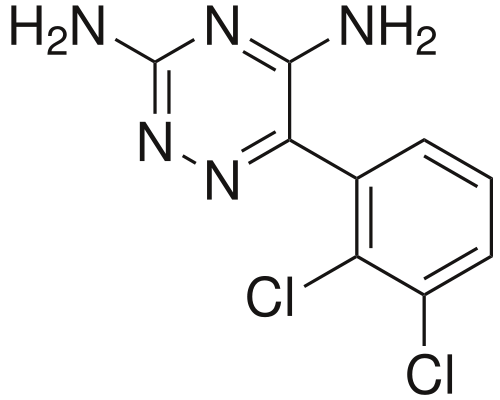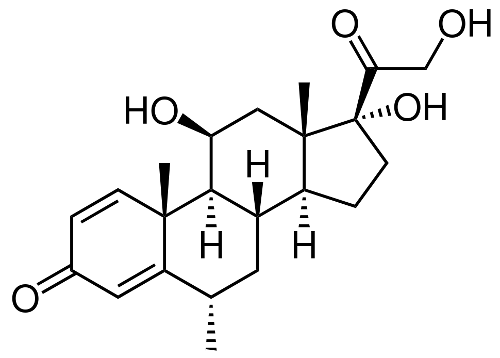Lametec Tablets (Generic Lamictal) - Active Ingredient And Chemical structure
The active ingredient contained in Lametec Tablets is Lamotrigine. Lamotrigine is a white to pale cream-colored powder and is very slightly soluble in water (0.17 mg/mL at 25°C) and slightly soluble in 0.1 M HCl. The structure is shown below

Generic Forms and Brand names of Lamictal
Lametec Tablets manufactured by Cipla Ltd., India is an effective treatment for Epilepsy adjunctive and mono therapy, generalized seizures of Lennox-Gastaut syndrome and Bipolar Disorder. Generic Lamictal which has the active ingredient Lamotrigine is also sold under various other brand names.
Lamictal Tablets (Lamotrigine) - Uses
Lamotrigine, an antiepileptic drug (AED) in the form of Lametec Tablets is used to treat the following indications:
Epilepsy-adjunctive therapy in patients 2 years of age or more:
partial seizures.
primary generalized tonic-clonic seizures.
generalized seizures of Lennox-Gastaut syndrome.
Epilepsy—monotherapy in patients 16 years of age or greater:
conversion to monotherapy in patients with partial seizures who are receiving treatment with carbamazepine, phenobarbital, phenytoin, primidone, or valproate as the single AED.
Bipolar Disorder in patients 18 years of age and above:
maintenance treatment of Bipolar I Disorder to delay the time to occurrence of mood episodes in patients treated for acute mood episodes with standard therapy.
Lametec Tablets (Generic Lamictal) - Preparations
Lametec is available as tablets of 25 mg, 50 mg and 100 mg .Each dispersible tablet contains Lamotrigine 25 mg, 50 mg and 100 mg respectively.
Lametec Tablets - Storage Requirements
Lametec Tablets are to be stored at room temperature (15°C to 30°C). Store away from heat, moisture, and light.
Lametec Tablets (Lamotrigine) - Mechanism of Action
The exact ways by which lamotrigine (Lametec Tablets) exerts its anticonvulsant action are unknown. In animal models that were designed to detect anticonvulsant activity, lamotrigine was effective in preventing seizure spread in the maximum electroshock (MES) and pentylenetetrazol (scMet) tests, and prevented seizures in the visually and electrically evoked after-discharge (EEAD) tests for antiepileptic activity.
Lametec Tablets (Lamotrigine) - Dosage
The Dosage for Lametec Tablets is based on concomitant medications, indication, and the age of the patient. To avoid an increased risk of rash, the recommended initial dose and subsequent dose escalations should not be exceeded. Lametec (Lamotrigine) Tablets should be swallowed with water.
Monotherapy with Lametec in patients 16 years of age or more:
Lametec is to be titrated to the targeted dose of 50 mg/day while maintaining the dose of the enzyme-inducing antiepileptic drugs(EIAEDs) at a fixed level. The EIAEDs are then gradually withdrawn over a period of 4 weeks.Recommended maintenance dose of Lametec DT as monotherapy is 500 mg/day given in two divided doses.
Bipolar Disorder:
The recommended initial adult dosage of Lametec DT is 25 mg once daily for 2 weeks, followed by 50 mg once daily for 2 weeks.
The recommended adult (over 12 years) dosage for lametec (mg/day) is given below
| | Weeks 1 & 2 | Weeks 3 & 4 | Usual Maintenance Dose |
| With enzyme-inducing antiepileptic drugs(EIAEDs) & No Valproic acid (VPA) | 50mg/day (Once a day) | 100mg/day (Two divided doses) | 300mg to 500mg/day (Two divided doses). To achieve maintenence doses may be incresed by 100mg/day every 1-2 weeks |
| EIAEDs & Valproic acid (VPA) | 25 mg every other day | 25mg (Once a day) | 100mg to 400mg/day (Two divided doses). To achieve maintenence doses may be incresed by 25 mg - 50mg/day every 1-2 weeks |
As there exists a risk of rash the initial dose and subsequent dose escalation should not be exceeded.
The recommended dose escalation for lamotrigine (lametec) for children aged 2-12 years (total daily dose in mg/kg body weight/day) on combined drug therapy is given below.
| | Weeks 1 & 2 | Weeks 3 & | Usual Maintenance Dose |
| With AED regimen containing VPA | 0.15mg/kg/day (1 or 2 divided doses) | 0.3mg/kg/day (1 or 2 divided doses) | 1mg - 5mg/kg/day (Maximum 200mg/day in One or Two divided doses)To achieve maintenence doses may be incresed by 0.5 - 1mg/kg/day every 1-2 weeks |
| Added to EIAEDs and wirhout VPA | 0.6mg/kg/day (2 divided doses) | 1.2mg/kg/day (2 divided doses) | 5mg - 15mg/kg/day (Maximum 400mg/day in One or Two divided doses)To achieve maintenence doses may be incresed by 2 - 3mg/kg/day every 1-2 weeks |
After initial 4 weeks of therapy, the daily dosage of Lametec DT may be doubled at weekly intervals until an effective maintenance dosage of 200 mg daily is reached. The daily dosages should not exceed 200 mg daily.
Lametec DT Tablets - Contraindications
Lametec DT Tablets are contraindicated in patients who have demonstrated hypersensitivity to Lamotrigine or any inactive ingredient present in the medicine.
Side Effects Of Lametec DT Tablets (Generic Lamictal or Lamotrigine)
The common adverse effects (incidence 10% or greater) of Lamotrigine (Lametec DT Tablets) in adult epilepsy clinical studies were dizziness, headache, diplopia, ataxia, nausea, blurred vision, somnolence, rhinitis, and rash.
Additional adverse reactions (incidence 10% or greater) reported in children in epilepsy clinical studies included vomiting, infection, fever, accidental injury, pharyngitis, abdominal pain, and tremor. Most common adverse effects with an incidence rate 5% or more in adult bipolar clinical studies were nausea, insomnia, somnolence, back pain, fatigue, rash, rhinitis, abdominal pain, and xerostomia.
Further Information
Prescribing Information


